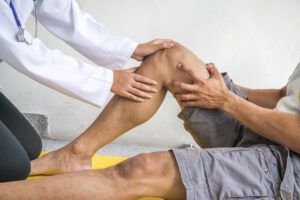Achilles tendon injuries are among the most common and debilitating conditions affecting the lower leg, especially in athletes and active individuals. The Achilles tendon is the largest tendon in the human body, connecting the calf muscles to the heel bone. It plays a critical role in walking, running, and jumping. When injured, it can significantly impair mobility and lead to prolonged recovery times. At Premier Orthopaedics & Sports Medicine, P.C., with locations in Bloomfield, Englewood, and Union City, NJ, understanding the full scope of treatment options for Achilles tendon injuries—both non-surgical and surgical—is vital for making informed health decisions.
Understanding the Achilles Tendon and Its Vulnerability
The Achilles tendon is a fibrous band of tissue that serves as the primary connector between the gastrocnemius and soleus muscles in the calf and the calcaneus (heel bone). Its primary function is to facilitate movement by transferring force from the leg muscles to the foot, allowing activities such as standing on tiptoe, walking, and pushing off the ground during running. Despite its strength, the Achilles tendon is particularly susceptible to injuries due to its limited blood supply and the immense strain it regularly endures.
Common injuries to the Achilles tendon include tendinitis, tendinosis, and tendon rupture. Tendinitis involves inflammation of the tendon, often due to overuse or sudden increases in physical activity. Tendinosis refers to degeneration of the tendon fibers caused by chronic wear and tear. A rupture, which is the most severe form of injury, involves a partial or complete tear of the tendon and typically results from a sudden, forceful motion. Understanding the different types of Achilles tendon injuries is crucial in determining the most appropriate course of treatment.
Causes and Risk Factors of Achilles Tendon Injuries
Achilles tendon injuries can occur in various ways, and while they are common in athletes, anyone can be at risk. Overuse is a leading cause, especially in runners or individuals who participate in sports that involve jumping and pivoting. An abrupt increase in physical activity without proper conditioning or stretching can overload the tendon and lead to inflammation or tearing. Wearing improper footwear or training on hard surfaces can further increase stress on the tendon.
Several risk factors also contribute to the likelihood of injury. Age is one important factor, as tendons naturally lose elasticity and become more prone to injury over time. Men over the age of 30 are particularly susceptible to Achilles tendon ruptures. Certain medical conditions, such as obesity and diabetes, can also weaken tendon structure. Additionally, the use of medications like fluoroquinolone antibiotics and corticosteroids has been associated with an increased risk of tendon injury. Recognizing these risk factors helps in both prevention and early diagnosis.
Symptoms and Diagnosis
Symptoms of an Achilles tendon injury can vary depending on the severity and type of injury. In cases of Achilles tendinitis, patients may experience a dull or sharp pain in the back of the heel, especially after physical activity. Swelling, stiffness, and tenderness along the tendon are common. The pain often worsens with prolonged activity and improves with rest. In chronic cases, the tendon may feel thickened or develop nodules.
A sudden pop or snap followed by severe pain and difficulty walking may indicate a tendon rupture. Individuals often describe the sensation as being kicked or hit in the back of the leg. In a complete rupture, the ability to push off the foot or stand on tiptoe is typically lost. Diagnosis involves a physical examination, during which a healthcare provider may perform the Thompson test—squeezing the calf muscle to observe foot movement. Imaging such as ultrasound or MRI can confirm the diagnosis and determine the extent of tendon damage, which is essential for formulating a treatment plan.
Non-Surgical Treatment Options
Non-surgical management is often appropriate for less severe Achilles tendon injuries, particularly in cases of tendinitis or small, partial tears. The primary goal is to reduce inflammation, relieve pain, and promote tendon healing. Initial treatment usually includes rest and modification of activity to avoid placing stress on the tendon. Applying ice, elevating the foot, and using compression can help reduce swelling in the early stages.
Nonsteroidal anti-inflammatory drugs (NSAIDs) are often recommended to manage pain and inflammation. Physical therapy plays a central role in recovery, with exercises designed to stretch and strengthen the calf muscles and improve flexibility in the tendon. Eccentric strengthening exercises, in particular, have shown great success in managing chronic tendinopathy. Orthotics or heel lifts may be prescribed to reduce tendon strain during walking. In some cases, immobilization using a walking boot or brace may be necessary to protect the tendon and allow for healing.
For patients with persistent symptoms, newer therapies such as platelet-rich plasma (PRP) injections or shockwave therapy have shown promise, although more research is needed to fully validate their effectiveness. Non-surgical approaches generally have fewer complications and are often preferred for less active individuals or those with medical conditions that increase surgical risk.
Surgical Treatment for Severe Injuries
When non-surgical treatments fail or when there is a complete rupture of the Achilles tendon, surgery may be the most appropriate option. The objective of surgery is to reattach or reconstruct the damaged tendon and restore full strength and function. Surgical repair typically involves making an incision along the back of the ankle and stitching the torn ends of the tendon together. In cases where the tendon is severely damaged or frayed, grafts may be used to reinforce the repair.
There are several surgical techniques available, including traditional open surgery and minimally invasive procedures. The choice depends on factors such as the location and extent of the tear, the patient’s overall health, and the surgeon’s experience. Minimally invasive methods may result in smaller incisions, reduced scarring, and a quicker recovery time. However, open surgery allows for better visualization of the tendon and may be preferred in complex cases.
While surgical intervention carries risks such as infection, nerve injury, or re-rupture, advances in surgical techniques and post-operative care have significantly improved outcomes. Surgery is especially effective for younger, active individuals who aim to return to sports or physically demanding jobs.
Rehabilitation and Recovery Process
Recovery from an Achilles tendon injury—whether treated non-surgically or surgically—requires a structured rehabilitation program to restore function and prevent recurrence. The recovery timeline varies based on the severity of the injury and the treatment method used. Generally, non-surgical recovery may take around 3 to 6 months, while post-surgical recovery can extend to 6 to 12 months.
The initial phase of rehabilitation focuses on protecting the tendon while allowing the surrounding tissues to heal. This may involve wearing a walking boot or cast and limiting weight-bearing activities. As healing progresses, physical therapy becomes increasingly important. Exercises are gradually introduced to improve range of motion, strength, and coordination. Balance training is particularly crucial to reduce the risk of re-injury.
Return to normal activity should be guided by a healthcare professional and based on functional milestones rather than a fixed timeline. Athletes and active individuals must be cautious and adhere strictly to their rehab protocols. Rushing back to activity too soon can compromise healing and increase the likelihood of complications. Long-term success relies heavily on the quality and consistency of rehabilitation.
Preventing Achilles Tendon Injuries
Prevention plays a vital role in reducing the risk of Achilles tendon injuries, especially for individuals involved in high-impact sports or repetitive physical activity. Proper warm-up and stretching routines before exercise can significantly reduce strain on the tendon. Eccentric strengthening of the calf muscles, regular cross-training, and rest days can help balance workload and promote tendon health.
Wearing supportive footwear with adequate cushioning is also critical, particularly for runners and individuals with flat feet or high arches. Avoiding sudden increases in training intensity or duration is essential in preventing overuse injuries. For those with a history of tendon issues, the use of heel lifts, orthotics, or bracing may provide added protection.
Being proactive about body mechanics, flexibility, and strength can go a long way in maintaining Achilles tendon integrity. Awareness of risk factors and early intervention at the first sign of pain or stiffness can prevent more serious injuries from developing.
Conclusion
Achilles tendon injuries can vary from mild tendinitis to complete ruptures, each requiring a different approach to treatment. Non-surgical methods often suffice for minor or moderate injuries, while surgery may be necessary for more severe cases to ensure a full recovery. By understanding the structure of the Achilles tendon, recognizing symptoms early, and committing to a comprehensive rehabilitation plan, individuals can significantly improve their chances of returning to pain-free movement. For those living in Bloomfield, Englewood, or Union City, NJ, Premier Orthopaedics & Sports Medicine, P.C. emphasizes the importance of timely care and informed decision-making when dealing with these complex injuries.
Sources:
Maffulli, N., Longo, U. G., Gougoulias, N., Loppini, M., & Denaro, V. (2011). Long-term health outcomes of Achilles tendinopathy. Sports Medicine, 41(10), 865–888.
Soroceanu, A., Sidhwa, F., Aarabi, S., Kaufman, A., & Glazebrook, M. (2012). Surgical versus nonsurgical treatment of acute Achilles tendon rupture. Journal of Bone and Joint Surgery, 94(23), 2136–2143.
Khan, K. M., Cook, J. L., Bonar, F., Harcourt, P., & Astrom, M. (1999). Histopathology of common tendinopathies. Clinical Sports Medicine, 18(3), 519–




